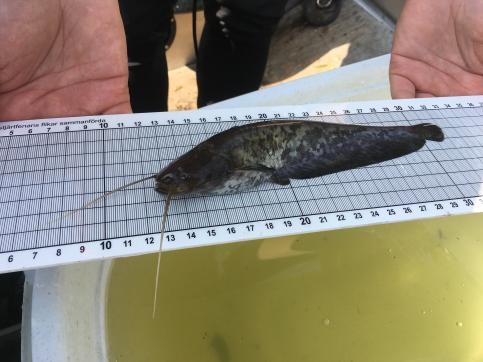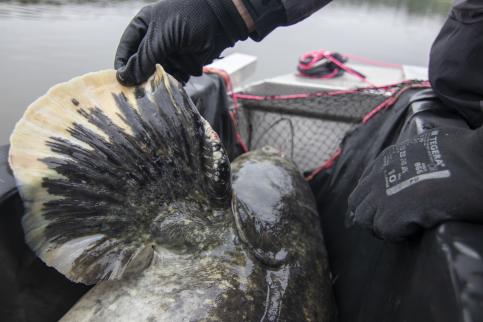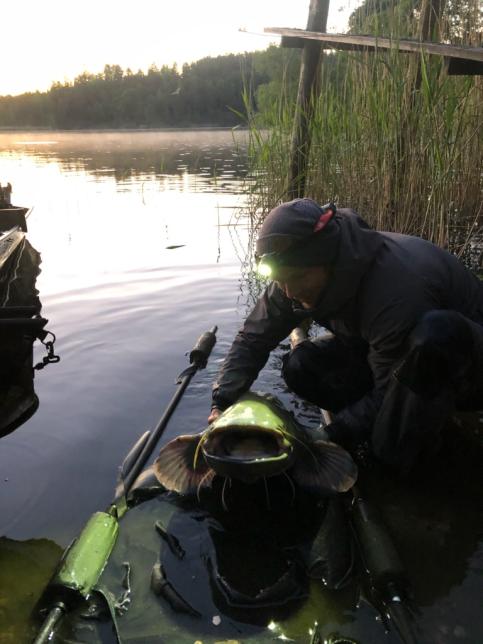Discussion
Habitat preferences
My results indicate that wels catfish preferred deeper parts of Lillsjön than randomly expected, the only exception occurred in June, possibly indicating spawning behavior. If shallow depth use is indeed indicative of spawning behavior, then spawning mainly took place in May - June 2020, which is earlier than what is predicted at the species northernmost distribution areas based on studies from central Europe.
Identifying the spawning period makes it possible to aid the species during this crucial stage, by for example protecting important spawning sites such as areas with sunken terrestrial vegetation and limiting fishing and boat traffic in these areas. Identifying the spawning period also enables studies on the spawning needs of the species to be properly planned and executed, such as where artificial spawning nests should be placed to improve reproductive success. This is essential for conservation as low reproductive success is believed to be the biggest problem for the Swedish population, causing low genetic diversity and high vulnerability to environmental changes. It is important to note that the spawning period might vary from year to year depending on water temperature, meaning that a potential ban on fishing and boat traffic at spawning areas might need to be applied for longer periods of time such as between May and August.
As the results indicate a general preference for deeper areas, conservation efforts that mainly focuses on improving the biotope close the shoreline might be limited in effectiveness. Adults will likely benefit more from conservation measures focusing on areas deeper than two meters, such as placing logs and rocks in deep areas relatively close to frequently utilized feeding grounds, as such areas are frequently used. It is however important to remember that this study focuses on adults, meaning that shallow and heavily vegetated areas might prove to be very important for the population, acting as feeding grounds and nurseries while providing young individuals with protection from predation.

Seasonal and diurnal variation in behavior
Activity of wels catfish was highest during summer and lowest during winter when the species practically did not feed at all, likely due to low water temperature. The species was also more active during the night, visiting shallower regions than during the day, possibly motivated by hunger stimulus.
The fact that wels catfish in this study preferred shallower regions during the night than during the day has several ecological implications when combing this finding with the nocturnal activity pattern. It infers that wels catfish utilized shallower regions when searching for food items during the night, compared to during the day when activity was lower and fish preferred deeper regions, presumably for resting. This implies that ideal habitat for adult wels catfish could be areas where deep regions with a lot of protective structures (fallen trees, sunken boats, deep holes in the lakebed etc.) lie close to shallow vegetated regions holding large amounts of food items such as cyprinid fish and crayfish.

Site fidelity
Home range size was highest during summer and lowest during winter. Overall site fidelity did however remain somewhat identical during the year as wels catfish utilized areas the size of 2-9 ha (50% AKDE), indicating that each individual had a small core area that it frequently returned to.
Wels catfish frequently utilizing small core areas (50% AKDE), has been observed in previous studies. Surprisingly, the size of the core areas did not vary as much between the seasons as the larger home areas (95% AKDE), suggesting that explorative behavior decreased during the winter but not necessarily the size of core home areas. The difference between the results of the 95% and 50% AKDE likely means that size of resting areas did not change much between the seasons, while exploration increased drastically during the warmer months.

Conservation implications
My results indicate that shallow areas with a lot of vegetation and food items adjacent to deep “holes” with underwater structures such as sunken vegetation, rocks or pits in the lakebed are important for the future reproductive success and survivability of wels catfish in Sweden. These areas fulfill needs for foraging, resting, hibernation and reproduction while simultaneously acting as nurseries for juveniles. Conservation efforts should preferably prioritize areas that fulfills these criteria in Swedish lakes and rivers holding the species.

Responsible for this page:
Director of undergraduate studies Biology
Last updated:
05/13/21
